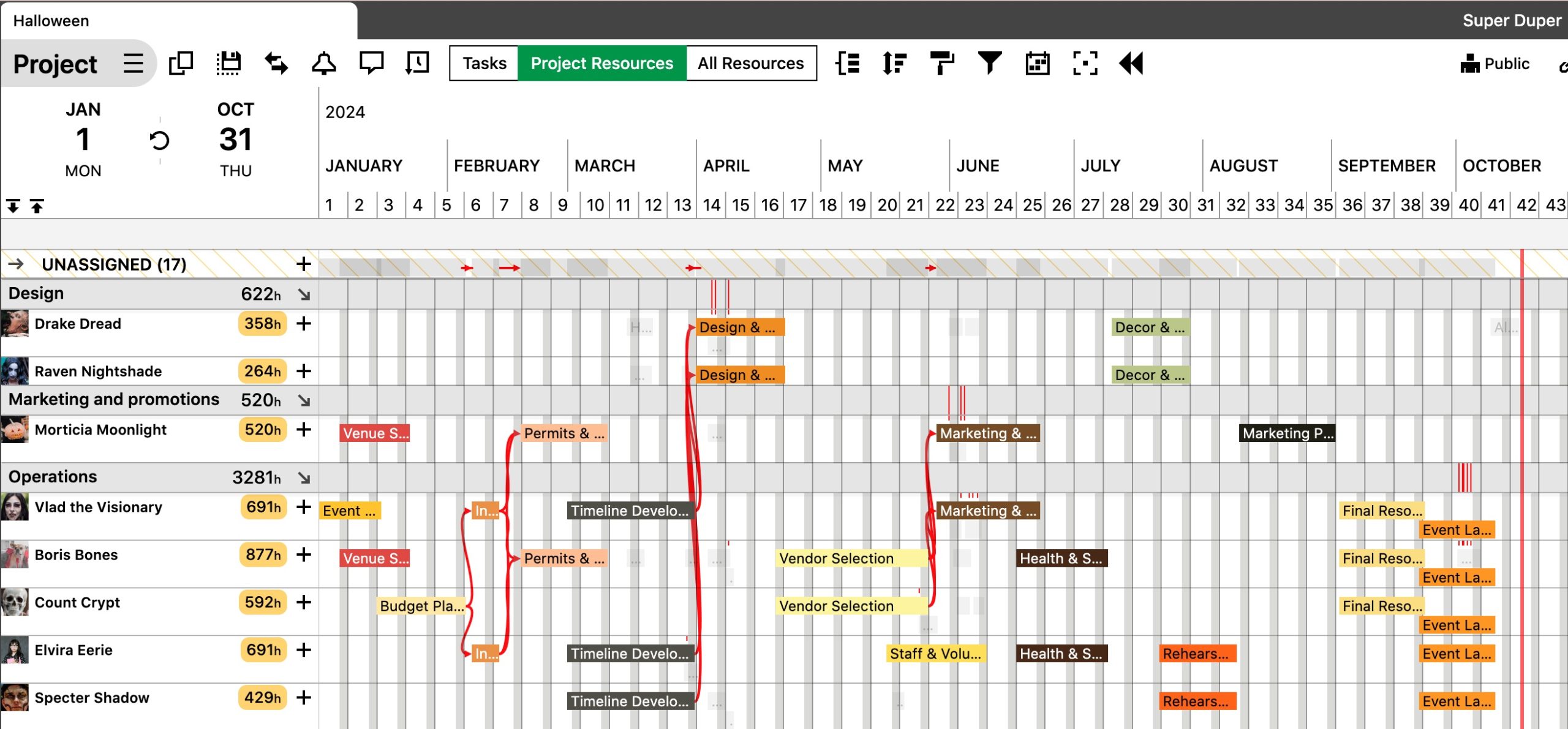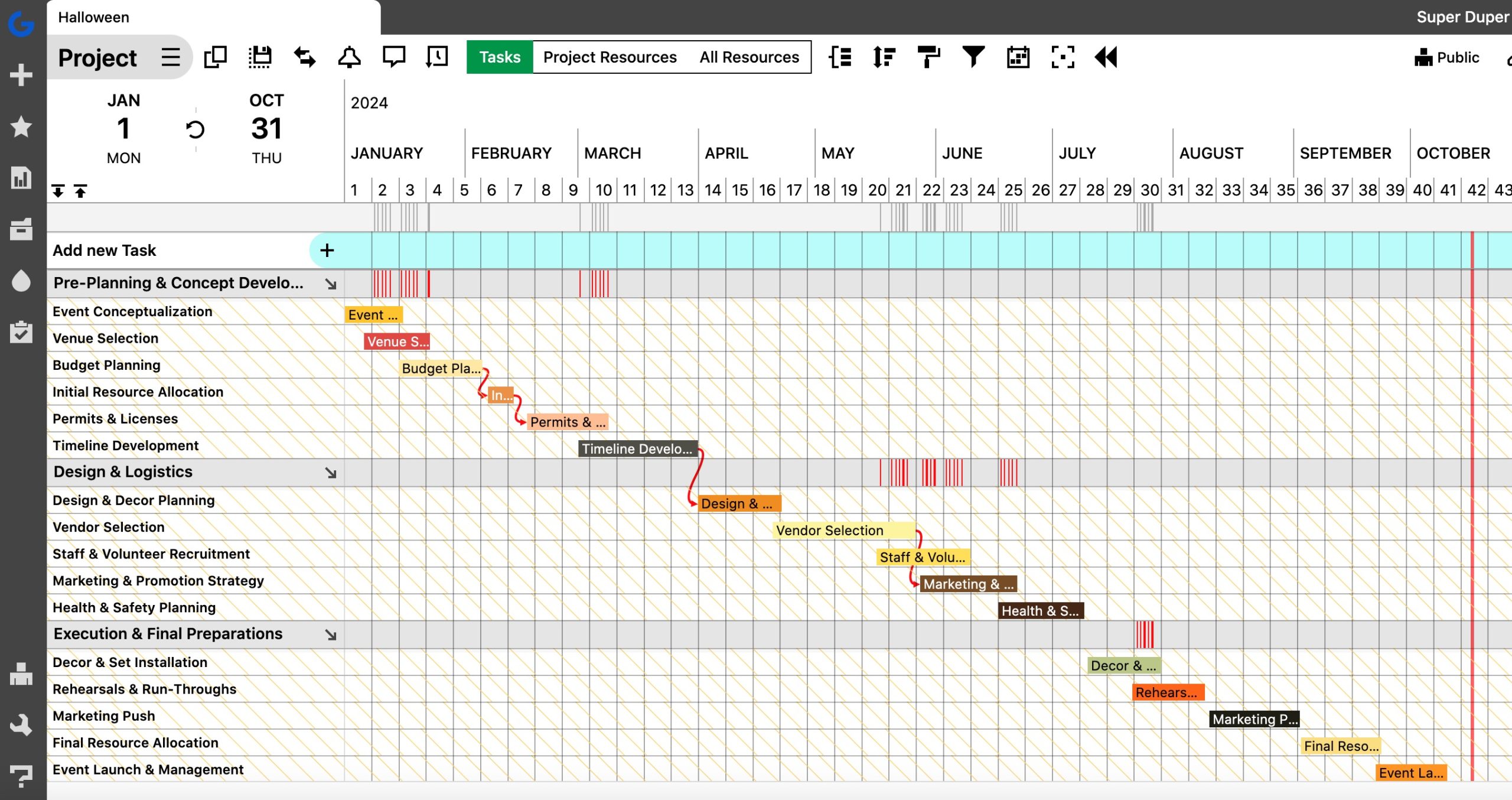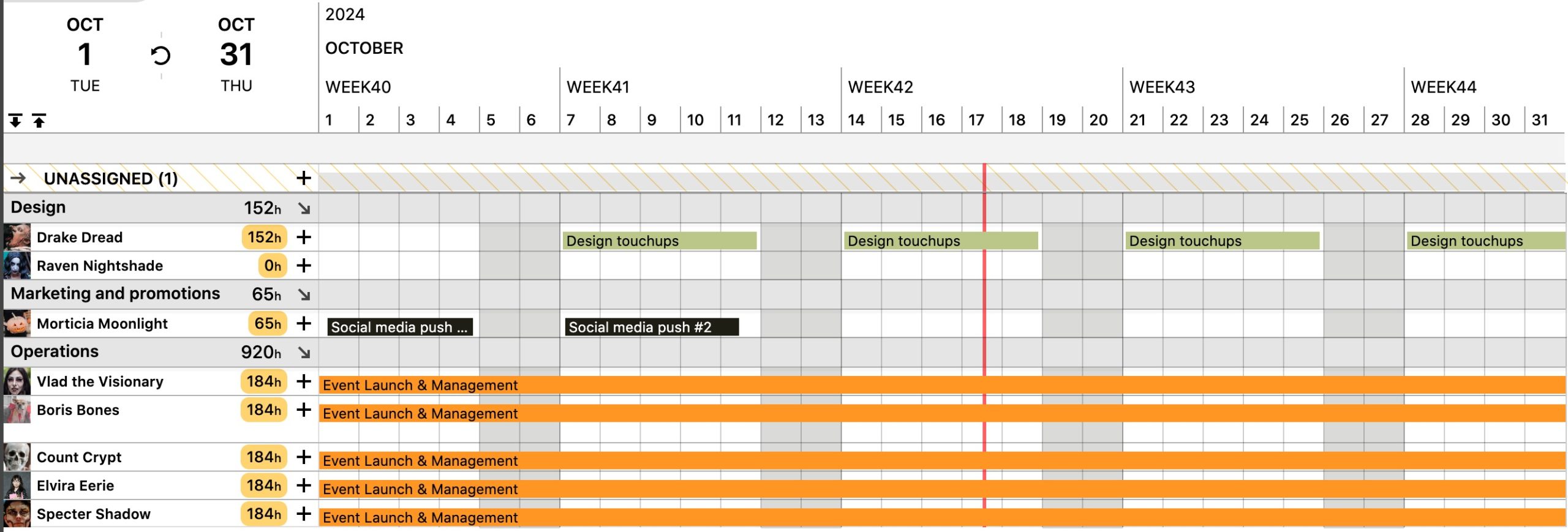Halloween is one of the most exciting times of the year for both businesses and individuals. It’s an opportunity for companies to engage with customers, employees, and communities through creative and fun events. However, planning a successful Halloween event requires meticulous organization, resource management, and coordination.
Whether you’re planning a spooky corporate party, a community Halloween festival, or a large-scale haunted house, by streamlining resource allocation, scheduling, and communication, you can ensure your event runs smoothly from start to finish. In this article, we’ll dive into how to simplify and optimize your Halloween event planning.
What kind of resources need planning for halloween events ?
Whether you’re a creature effects designer, an event planner, a creative designer, or the director of a rentable venue, planning a Halloween event requires careful coordination to avoid chaos. Industries like entertainment, hospitality, marketing, and even corporate offices often host themed events ranging from haunted houses and community festivals to spooky office parties.
With so many moving parts—actors, props, decorations, and costumes—things can get frightening fast without a solid plan in place. That’s why having the right tools to manage these resources is crucial for pulling off a successful, scare-free event!
Here’s a few Halloween events and the resources that they each require.
- Haunted House – From actors to makeup artists, set designers, prop masters, and sound technicians, every detail is key to crafting a spooky experience.
- Halloween Parade – You’ll need float builders, performers, decorators, sound crews, security, and vendors to pull off a large, fun-filled parade.
- Halloween Party – Coordinate caterers, decorators, costume judges, entertainment providers, and venue staff to create a memorable celebration.
- Themed Escape Room – Puzzle designers, actors, prop specialists, AV technicians, and booking staff create an immersive escape room experience.
- Halloween Charity Event – Fundraising volunteers, event hosts, venue managers, promotional teams, and security staff make this event both fun and impactful.
- Pumpkin Patch or Corn Maze – Field setup crews, ticketing staff, decorators, food vendors, photographers, and safety personnel ensure a day of fall fun for all ages.
Tips for Halloween event planning
1. Organize your crew and supplies
One of the biggest challenges in event planning is managing multiple resources, such as staff, equipment, and venue space. With software, you can easily organize these resources in a single, centralized platform.
Example: For a Halloween event, you’ll likely have different teams working on specific tasks (e.g., decorations, catering, entertainment). A resource planner will allow you to assign each team their responsibilities and schedule resources like sound systems, decorations, lighting, and catering services. All without overlap or confusion.
 Create a resource Gantt chart in Ganttic to start planning your Halloween event months in advance.
Create a resource Gantt chart in Ganttic to start planning your Halloween event months in advance.
By using tools like a resource Gantt chart, you can track which resources are available, when they’re needed, and assign tasks accordingly. You’ll know exactly who’s doing what and when, preventing resource conflicts or overbookings, which can often occur in large event setups.
2. Keeping everyone on the same page
Halloween events can be elaborate productions involving a wide range of stakeholders. Whether it’s a team of designers building elaborate haunted house sets or a catering company prepping themed food and beverages, collaboration is key.
With online tools, your entire team can work together in real-time. The software allows for seamless communication and collaboration. And ensures that all team members are aware of updates, changes, or potential issues.
Things to keep in mind when collaborating:
- Shared Timelines: Every team member can access shared event schedules, allowing for real-time updates and adjustments.
- Live Changes: If something changes—like the arrival time of a DJ or delivery of costume materials—your team will see it immediately.
- Commenting Features: Keep the conversation going by leaving notes and comments directly within the task interface. This reduces the chances of miscommunication via emails or messages.
3. Task prioritization: ensuring deadlines are met
One of the key elements of event planning is timing. In the lead-up to Halloween, time is of the essence, and the last thing you want is for important tasks to fall behind schedule.
Halloween’s date doesn’t change year to year, so that gives you a good estimate of when to get started with your event planning. A successful event takes anywhere from 3-12 months to pull off. So that gives you a head start to planning all the tasks and gathering resources. By creating a resource plan, you’ll have the first step done in advance.
 A work breakdown structure of your Halloween event – including all the tasks, phases, and dependencies.
A work breakdown structure of your Halloween event – including all the tasks, phases, and dependencies.
To do this, you’ll need to prioritize tasks based on deadlines, ensuring that everything from ordering decorations to booking entertainment is done on time. You can set task dependencies, meaning that one task cannot start until the previous one is complete. This is vital for large events where many different aspects are interdependent.
Example: If your Halloween event includes a complex lighting setup for an outdoor space, the lighting team may not be able to start until the stage has been constructed. Dependencies ensure that tasks like these are prioritized correctly and are executed in the right order, minimizing downtime.
4. Tracking and monitoring progress: avoid last-minute stress
With so many moving parts, it’s easy to lose track of progress during event planning. Online Gantt charts provide a comprehensive overview of what’s been completed, what’s in progress, and what still needs attention. The visual Gantt chart offers a bird’s-eye view, so you can quickly assess if things are on track or if certain areas require immediate action.
Benefit: The ability to monitor real-time progress ensures that you can adjust your strategy if necessary. Helping you avoid potential last-minute crises that could derail your Halloween event.
5. Flexibility: Adapting to Changes and Contingencies
No event plan is immune to change, and Halloween events are no different. Unexpected delays, changes in vendor availability, or weather issues may require you to make last-minute adjustments. Online resource planning tools provide the flexibility you need to adapt to these changes seamlessly.
 Add last minute changes to the schedule and keep your Halloween event on track for success.
Add last minute changes to the schedule and keep your Halloween event on track for success.
With the drag-and-drop interface, reassigning tasks, changing deadlines, or rebooking resources can be done in a matter of seconds, ensuring that your event is still on track despite any unforeseen challenges.
With software it’s also easy to make recurring tasks, if you need them to repeat until the end of the event.
6. Post-Event Reporting: Learning for Future Events
Once your Halloween event is over, software allows you to analyze and assess the performance of your planning process. You can review which resources were over or underutilized, which tasks were completed on time, and where bottlenecks occurred.
 Charts and reports give you a rundown of your team’s time, making it easy to plan more accurately for your next event.
Charts and reports give you a rundown of your team’s time, making it easy to plan more accurately for your next event.
This data is invaluable for improving future events. If you’re planning an even bigger Halloween event next year, you’ll have insights on how to improve your resource allocation and time management, making future events even more successful.
Plan a Spooktacular Halloween Event with Ganttic
Ganttic’s powerful resource management features are designed to streamline the complex process of event planning. From organizing teams and equipment to real-time collaboration and post-event analysis, Ganttic ensures your Halloween event runs smoothly, efficiently, and without a hitch.
By utilizing Ganttic’s flexible, intuitive, and visual planner, you can reduce stress, stay on top of every detail, and deliver an unforgettable Halloween experience for your team and guests.
Whether you’re organizing a corporate Halloween bash or a community-wide haunted attraction, Ganttic has helped thousands of clients with creative agencies make their event planning as smooth as possible—so you can focus on delivering the spooky magic.